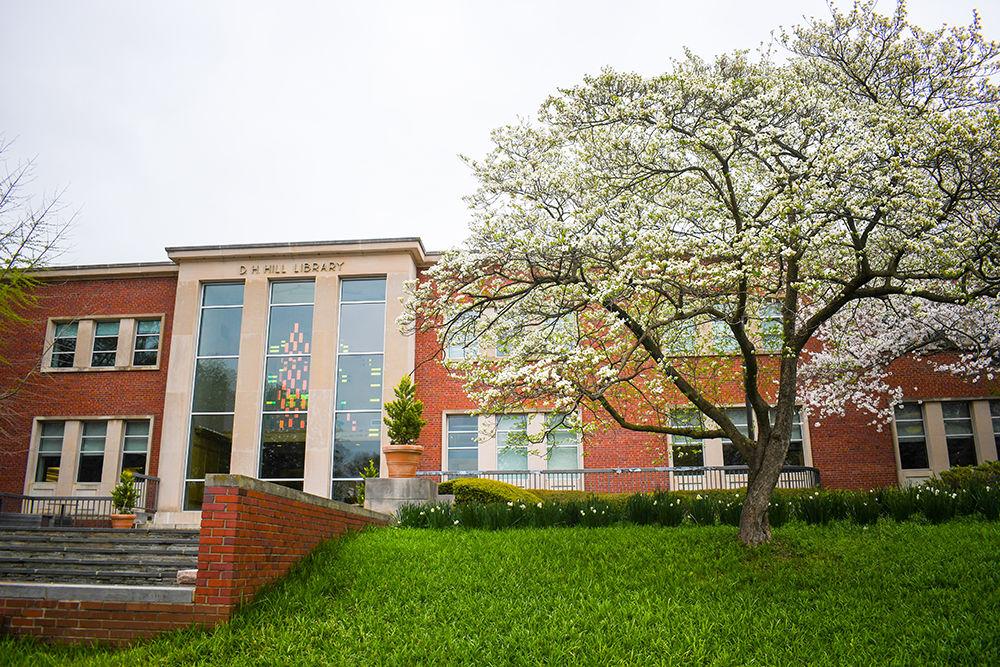
Sarah Cochran
DH Hill Library on Thursday, March 26, 2020 on NC State University's main campus.
On Thursday, March 3, students, staff and community members gathered in D.H. Hill Jr. Library’s auditorium for the first showing of the Lights, Camera, Language film series put on by NC State Language Diversity Ambassadors in partnership with University Libraries. The film series features work that explores the way language interacts with and informs culture and ideology.
Language Diversity Ambassadors work to increase awareness of language diversity on campus via workshops surrounding language and diversity. Featured topics include dialect diversity in North Carolina, linguistic discrimination, linguistic diversity in higher education and more. They also host other educational events, such as the film series.
According to Kees Koopman, a graduate student studying English linguistics and the treasurer for Language Diversity Ambassadors, discussions of linguistic diversity are particularly important on university campuses.
“[Linguistics] has a lot to offer in terms of helping us to understand our increasingly multicultural, globalized world,” Koopman said. “It also has a lot to offer in terms of teaching scientific processes and the scientific method in a very approachable way because, in a sense, every person is their own research subject, and every conversation is like a lab.”
Thursday’s film, “Talking Black in America,” is the first of a five-part documentary film series exploring the history, importance, implications and impact of African American English (AAE) in the United States.
The film tracks the development of AAE from the outset of the American slave trade, looking at the different circumstances and influences that have led to its development.
One goal of the film was to dispel the misperception of AAE as “broken” English without structure or rules. Approaching the film from a linguistic perspective allowed for a technical tracking of the historical influences which distinguish AAE from other language varieties. The linguistic lens also demonstrated the social importance of language development and how intrinsic understanding of the patterns within a language is vital to communication.
“It’s kind of a huge story in the American language scene,” said producer Neal Hutcheson. “Especially in terms of looking at languages and dialects as being non-standard and those language varieties as being stigmatized quite unfairly, but quite dramatically.”
“Talking Black in America” looks at how AAE interacts with religion, music and movement to create holistic communication full of subtleties and complexities unique to the language.
“There are probably more people that would have been English majors or writers in hip-hop than areas in any other [music] genre,” said rapper Quest M.C.O.D.Y. in the film. “Just the usage of words like metaphors, similes, double entendres, triple entendres. People think that African American English is picking up these things from hip hop, when in fact hip hop is making use of long standing features of African American English.”
After the showing, Hutcheson, producer Danica Cullinan and research assistant Marissa Morgan, who earned her masters degree in sociolinguistics from NC State, sat down with the audience for a Q&A. The trio used the word cathartic multiple times when discussing the emotional process of the production.
“It’s always very interesting to me the way that different people manage to make a point go straight to your head or straight to your heart, depending on the style that they use,” Cullinan said. “Regardless of their background, because everyone is in a way an expert on language and their own personal experience and connection with language.”
Lights, Camera, Language has two more showings throughout the remainder of the semester. It will show and discuss the science fiction feature film “Arrival” on Mar. 25 and “First Language,” which explores the importance and position of the Cherokee language on April 14, both at 7 p.m in the D.H. Hill Jr. Library auditorium.